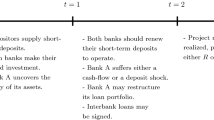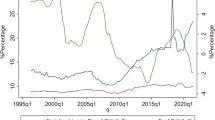Abstract
If a bank is facing insolvency, it will be tempted to reject good loans and accept bad loans so as to shift risk onto its creditors. We analyze the effectiveness of buying up toxic mortgages in troubled banks, buying preferred stock, and buying common stock. If bailing out banks deemed “too big to fail” involves buying assets at above fair market values, then these banks are encouraged ex ante to gamble on bad assets. Buying up common (preferred) stock is always the most (least) ex ante- and ex post-efficient type of capital infusion, regardless of whether the bank volunteers for the recapitalization.
Similar content being viewed by others
References
Acharya, S.: Charter value, minimum bank capital requirement and deposit insurance pricing in equilibrium. J. Bank. Finance 20, 351–375 (1996)
Acharya, V.V., Yorulmazer, T.: Too many to fail—an analysis of time-inconsistency in bank closure policies. J. Financ. Intermed. 16, 1–31 (2007)
Acharya, V.V., Yorulmazer, T.: Cash-in-the-market pricing and optimal resolution of bank failures. Rev. Financ. Stud. 21, 2705–2742 (2008)
Aghion, P., Bolton, P., Fries, S.: Optimal design of bank bailouts: the case of transition economies. J. Inst. Theor. Econ. 155, 51–70 (1999)
Armstrong, M., Cowan, S., Vickers, J.: Regulatory Reform: Economic Analysis and the British Experience. MIT Press, Cambridge (1994)
Ballard, C., Shoven, J., Whalley, J.: The total welfare cost of the united states tax system: a general equilibrium approach. Nat. Tax J. 38, 125–140 (1985)
Barrow, J.M., Horvitz, P.M.: Response of distressed firms to incentives: thrift institution performance under the fslic management consignment program. FM: J. Financ. Manag. Assoc. 22(3), 176–184 (1993)
Bebchuk, L.A.: A better plan for addressing the financial crisis. Economists’ Voice 5(5) (2008), Article 7
Bernhardsen, T., Kloster, A., Smith, E., Syrstad, O.: The financial crisis in Norway: effects on financial markets and measures taken. Finan. Mark. Portf. Manag. 23, 361–381 (2009)
Brommundt, B., Felsenheimer, J., Gisdakis, P., Zaiser, M.: Recent developments in credit markets. Financ. Mark. Portf. Manag. 20, 221–234 (2006)
Brown, C., Dinc, S.: Too many to fail? Evidence of regulatory reluctance in bank failures when the banking sector is weak. Rev. Financ. Stud. (2010, forthcoming)
Caballero, R.J., Hoshi, T., Kashyap, A.: Zombie lending and depressed restructuring in Japan. Am. Econ. Rev. 98, 1943–1977 (2008)
Chaney, P.K., Thakor, A.V.: Incentive effects of benevolent intervention, the case of government loan guarantees. J. Public Econ. 26, 169–189 (1985)
Congressional Budget Office: The troubled asset relief program: report on transactions through December 31, 2008 (2009)
Congressional Oversight Panel: February oversight report, valuing the treasury’s Assets, February 6, 2009 (2009)
Cordella, T., Yeyati, E.L.: Bank bailouts: moral hazard vs. value effect. J. Financ. Intermed. 12, 300–330 (2003)
Diamond, D.W., Rajan, R.G.: Bank bailouts and aggregate liquidity. Am. Econ. Rev. 92, 38–41 (2002)
Freixas, X.: Optimal bail out policy, conditionality and constructive ambiguity. Social Science Research Network (1999)
Goolsbee, A.: Taxes, organizational form and the dead weight loss of the corporate income tax. J. Public Econ. 69, 143–152 (1998)
Gorton, G., Huang, L.: Liquidity, efficiency, and bank bailouts. Am. Econ. Rev. 94, 455–483 (2004)
Harvey, C.R.: The financial crisis of 2008: what needs to happen after TARP. Working Paper, Duke University (2008)
Hoggarth, G., Reidhill, J., Sinclair, P.: On the resolution of banking crises: theory and evidence. Bank of England Working Paper No. 229 (2004)
Jensen, M.C., Meckling, W.H.: Theory of the firm: managerial behavior, agency costs and ownership structure. J. Financ. Econ. 3, 305–360 (1976)
Kasa, K., Spiegel, M.M.: The role of relative performance in bank closure decisions. Federal Reserve Bank of San Francisco, Economic Review, pp. 17–29 (2008)
Malaith, G.J., Mester, L.J.: A positive analysis of bank closure. J. Financ. Intermed. 3, 272–299 (1994)
Merton, R.C.: On the pricing of corporate debt: the risk structure of interest rates. J. Finance 29, 449–470 (1974)
Rochet, J.C., Tirole, J.: Interbank lending and systemic risk. J. Money Credit Bank. 28, 733–762 (1996)
Sarkar, A.: Liquidity risk, credit risk, and the federal reserve’s responses to the crisis. Financ. Mark. Portf. Manag. 23, 335–348 (2009)
SIGTARP: Office of the Special Inspector General for the Troubled Asset Relief Program, Factors affecting efforts to limit payments to AIG counterparties, SIGTARP-10-003, November 17, 2009
Veronesi, P., Zingales, L.: Paulson’s gift. Working Paper, University of Chicago (2008)
Wilson, L.: Debt overhang and bank bailouts. Social Science Research Network (2009)
Wilson, L.: The put problem with buying toxic assets. Appl. Financ. Econ. 20(1–2), 31–35 (2010)
Zingales, L.: Why Paulson is wrong. Economists’ Voice 5(5), Article 3 (2008)
Author information
Authors and Affiliations
Corresponding author
Rights and permissions
About this article
Cite this article
Wilson, L., Wu, Y.W. Common (stock) sense about risk-shifting and bank bailouts. Financ Mark Portf Manag 24, 3–29 (2010). https://doi.org/10.1007/s11408-009-0125-y
Published:
Issue Date:
DOI: https://doi.org/10.1007/s11408-009-0125-y
Keywords
- Asset substitution
- Banks
- Bailout
- Capital Assistance Program (CAP)
- Capital Purchase Program (CPP)
- Capital structure
- Emergency Economic Stabilization Act (EESA)
- Lehman Brothers
- Public-Private Investment Program (P-PIP)
- Lending
- Risk-shifting
- Too big to fail
- Troubled Asset Relief Program (TARP)





